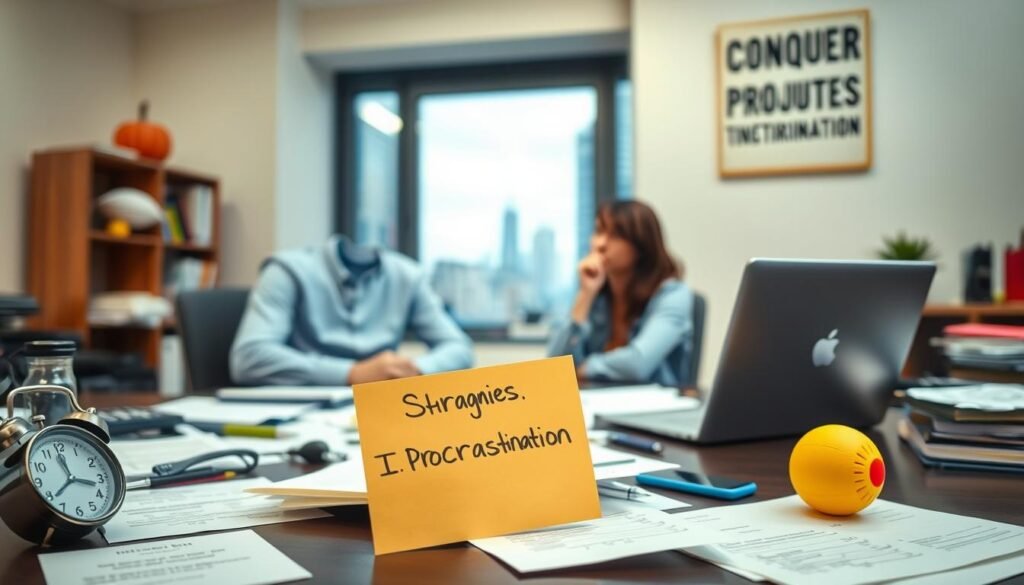Have you ever found yourself staring at a blank page, knowing you have a deadline looming but feeling completely stuck? You’re not alone. Many students struggle with delaying tasks, which can lead to stress and lower grades. The good news is, there’s a way to turn this around.
We’ve developed a practical, research-backed framework to help you overcome this challenge. This approach combines psychological insights with actionable strategies, making it easier to recognize patterns and break the cycle of delay. By following these steps, you can build lasting habits that support your academic success.
Real-world examples from teachers and students show how effective this plan can be. They’ve shared their experiences of how they managed to stay on track and achieve their goals. You’ll learn how to apply these strategies in your own life, making it easier to manage your time and focus on what’s important.
Key Takeaways
- Understand the impact of delaying tasks on your academic performance.
- Learn a practical, research-backed framework to overcome procrastination.
- Discover real-world examples of success from teachers and students.
- Combine psychological insights with actionable strategies.
- Build lasting habits to improve your time management and focus.
Understanding Procrastination and Its Impact
Putting off tasks until the last minute is a common struggle for many students. This habit, known as procrastination, involves voluntarily delaying tasks despite knowing the negative consequences. It’s not just about laziness; it’s often rooted in deeper psychological triggers.
Students procrastinate for various reasons. Fear of failure, feeling overwhelmed by tasks, boredom, exhaustion, and perfectionism are the five core triggers. Teachers often observe a “last-minute panic” as deadlines approach, highlighting how widespread this issue is in school life.
Procrastination doesn’t just affect academic performance; it impacts mental health too. When we delay tasks, our brain activates its stress response, leading to anxiety and chronic stress cycles. Over time, this can result in missed deadlines, rushed work, and even a 32% drop in GPA scores, according to research.
Understanding these patterns is the first step toward breaking the cycle. By recognizing the triggers and consequences, we can start to develop strategies to manage our time and focus more effectively.
Step 1: Recognize When You’re Procrastinating
Ever feel like you’re doing everything except the one thing you need to do? This is often the first sign of procrastination. It’s not always obvious, but recognizing it is the first step to overcoming it.
Identifying Procrastination Behaviors
Procrastination can take many forms. Sometimes, it looks like busy work—tasks that feel productive but aren’t actually moving you forward. For example, rewriting notes instead of starting an essay is a common trap. Other times, it’s endless planning or creating fake emergencies to avoid the real work.
How Procrastination Sneaks Up on You
It’s easy to get caught up in the moment and lose sight of your priorities. Physical signs like restlessness, avoidance behaviors, or decision paralysis can signal that you’re procrastinating. A simple checklist can help: “Am I working on priority tasks or just feeling busy?”
Examples of Procrastination in School
In school, procrastination often shows up as over-researching, excessive note-taking, or even “emergency” cleaning. These behaviors might feel productive, but they’re actually ways to avoid the main task. A 24-hour behavior tracking exercise can help you spot these patterns and take control.
Step 2: Break Down Overwhelm
Ever looked at a project and wondered where to even start? This feeling of overwhelm is common, especially when tasks seem too big or complex. The key is to break them into smaller, manageable parts.
Understanding Task Overwhelm
When we see a project as one giant task, it’s easy to feel stuck. For example, a science fair project might seem daunting until we divide it into smaller steps like research, experiments, and presentation. This approach reduces stress and makes the work feel achievable.
How to Break Tasks into Manageable Parts
Start by identifying the main components of your task. For instance, writing a history paper can be split into researching, outlining, drafting, and editing. Breaking it into these parts makes it less intimidating and easier to tackle one step at a time.
Creating a Step-by-Step Plan
Use tools like the Eisenhower Matrix to prioritize your steps. This method helps you focus on what’s urgent and important. For example, a teacher once divided a table-painting project into eight sub-tasks, making it easier for students to complete without feeling overwhelmed.
By converting a big project into a clear list of actionable steps, you’ll reduce anxiety and stay on track. One student shared how breaking an essay into micro-tasks helped them finish it without stress.
Step 3: Manage Your Time Effectively
Managing your time well can make a huge difference in how you handle your tasks. When we organize our day effectively, we reduce stress and increase productivity. This step focuses on practical strategies to help you stay on track and make the most of your day.

The Importance of Time Management
Effective time management is crucial for academic success. It helps you prioritize tasks, avoid last-minute rushes, and maintain a healthy balance between work and relaxation. Research shows that students who manage their time well often perform better in their studies.
Tools and Techniques for Time Management
There are several tools and techniques to help you manage your time better. The Pomodoro Technique, for example, involves working for 25 minutes followed by a 5-minute break. This method can improve focus by up to 40%. Another effective strategy is time blocking, which reduces task-switching costs by 27%.
Comparing digital tools like Google Calendar with analog methods like the Bullet Journal can help you find what works best for you. Teachers often recommend “Power Hours,” where students focus intensely on their work for set intervals, followed by short breaks.
Creating a Daily Schedule
Creating a daily schedule that aligns with your energy levels can boost productivity. Start by identifying your peak energy times and scheduling your most challenging tasks during these periods. A downloadable weekly planner template, optimized for school routines, can help you get started.
By analyzing typical time leaks, such as social media and unstructured study sessions, you can make adjustments to your plan. One teacher shared how dividing a project into focused work intervals helped students complete tasks without feeling overwhelmed.
Step 4: Tackle Fear and Anxiety
Why do we sometimes sabotage our own progress before we even begin? Often, it’s because of fear—fear of failure, fear of judgment, or even fear of success. These emotions can paralyze us, making it hard to take the first step. But understanding and addressing these feelings is key to moving forward.
Understanding Fear of Failure and Success
Fear of failure is one of the most common reasons we delay tasks. Research shows that 68% of academic delays stem from this fear. On the flip side, fear of success can also hold us back. We might worry about the pressure that comes with achieving our goals. Recognizing these fears is the first step to overcoming them.
Strategies to Overcome Fear and Anxiety
One effective technique is Fear Scaling. Rate your anxiety from 1 to 10 before and during tasks. This helps you understand how your brain reacts to stress. Another strategy is the “Worst-case scenario” exercise, which reduces anxiety by 44%. Mindfulness techniques like 4-7-8 breathing and grounding exercises can also calm your mind.
Building Confidence in Your Abilities
Confidence grows when we take small, consistent steps. Start a Success Journal to document your wins, no matter how small. For example, one student overcame their presentation phobia through gradual exposure. Celebrate your progress, and remember: every step forward is a victory.
By addressing fear and anxiety head-on, you can break the cycle of delay and build the confidence needed to succeed. Start small, stay consistent, and watch your progress grow.
Step 5: Take Action and Stay Consistent
Taking that first step can feel like the hardest part, but it’s also the most crucial. Once you start, momentum builds, making it easier to keep going. This step focuses on how to initiate action and maintain consistency in your efforts.
The Power of Taking the First Step
Research shows that “tiny first steps” increase task initiation by 300%. The 5-Minute Rule is a great way to overcome initial resistance. Commit to working on a task for just five minutes. Often, you’ll find yourself continuing beyond that time.
Another effective strategy is habit stacking. Link study sessions to existing routines, like reviewing notes after breakfast. This creates a natural flow and reduces the mental effort needed to start.
How to Stay Consistent with Your Plan
Consistency is key to long-term success. Break your plan into smaller, daily steps to make it manageable. For example, instead of aiming to finish an entire project in one day, focus on completing one section at a time.
Accountability partnerships can also help. Pair up with a study buddy to keep each other on track. Regular check-ins and shared goals create a sense of responsibility and motivation.
Rewarding Yourself for Progress
Celebrating small wins keeps you motivated. A teacher’s classroom reward system, where students earn tokens for completing tasks, boosts compliance by 65%. You can create your own reward system at home.
Here are some micro-reward ideas for academic milestones:
- Take a short walk after finishing a chapter.
- Enjoy a favorite snack after completing an assignment.
- Watch an episode of your favorite show after a productive study session.
By taking action, staying consistent, and rewarding yourself, you’ll build habits that support your academic success. Start small, stay focused, and celebrate your progress along the way.
Common Reasons Why Students Procrastinate
Many students find themselves stuck in a cycle of delaying tasks, unsure of how to break free. Understanding the root causes can help us address the issue more effectively. Let’s explore the three most common reasons behind this behavior.
Fear of Failure
One of the biggest barriers to getting started is the fear of not meeting expectations. This can lead to self-doubt and decision fatigue, making it hard to take the first step. Research shows that 42% of students cite unclear instructions as a trigger for procrastination.
Teachers often observe a pattern called the “September overwhelm,” where students struggle to adjust after the summer break. Recognizing this fear and addressing it through clear goals and support can make a significant difference.
Task Overwhelm
When a task feels too big or complex, it’s easy to feel stuck. Breaking it into smaller, manageable parts can reduce this overwhelm. For example, turning a math assignment into a game challenge can make it more engaging and less intimidating.
One teacher shared how dividing a project into smaller steps helped students stay on track. This approach not only reduces stress but also increases the likelihood of completing the task.
Lack of Motivation
Sometimes, the problem isn’t the task itself but the lack of motivation to start. Linking assignments to personal goals can boost motivation by 73%. A motivation mapping worksheet can help students connect their work to future aspirations.
It’s important to remember that waiting for inspiration is a myth. Taking small, consistent steps is key to building momentum and staying motivated in school.
Strategies to Overcome Procrastination
Finding effective ways to stay focused can transform how we approach our tasks. By implementing the right strategies, we can create a system that supports productivity and reduces distractions. Let’s explore three key approaches to help you stay on track.

Creating a Productive Environment
Your surroundings play a big role in how well you work. Environmental redesign can reduce distractions by 58%. Start by setting up a “focus zone” with proper lighting, ergonomic furniture, and minimal digital clutter. A teacher’s classroom design, for example, can prevent common triggers that lead to delays.
Another effective way is to use “Implementation Intentions.” This technique involves planning specific actions for specific situations. For instance, “When I sit at my desk, I’ll start my assignment immediately.” This simple strategy can help you stay focused and avoid unnecessary delays.
Using Positive Reinforcement
Rewarding yourself for progress can boost motivation and make tasks feel more manageable. Start by listing 15 productivity apps with school-specific features. These tools can help you stay organized and track your achievements.
Positive reinforcement also includes celebrating small wins. For example, take a short break after completing a task or treat yourself to something you enjoy. These small rewards can keep you motivated and make the work feel less overwhelming.
Seeking Support from Peers and Mentors
Study groups can improve accountability by 81%. Surrounding yourself with supportive people can make a big difference in your learning journey. Build a network of teachers, tutors, and study communities to share resources and stay motivated.
Having a mentor or study buddy can also help you stay on track. Regular check-ins and shared goals create a sense of responsibility and keep you focused on your tasks. Remember, you don’t have to do it all alone—support is just a conversation away.
How to Stay Motivated in School
Staying motivated can feel like an uphill battle, but with the right strategies, it becomes manageable. We’ll explore practical ways to keep your energy and focus high throughout the school year. By setting clear goals, tracking your progress, and celebrating small wins, you can create a system that supports your academic success.
Setting Clear Goals
Start by defining what you want to achieve. Using the SMART goal framework adapted for academic settings can help. For example, instead of saying, “I want to do better in math,” set a specific goal like, “I will improve my math grade by one letter level this semester.” Goal visualization increases persistence by 33%, making it easier to stay on track.
Tracking Your Progress
Monitoring your achievements keeps you accountable. Try using color-coded semester maps or a Victory Log system inspired by college athletes. Research shows that students who track their progress improve their grades by 1.5 letter levels. Regularly reviewing your milestones helps you see how far you’ve come and what’s left to achieve.
Celebrating Small Wins
Recognizing your efforts, no matter how small, boosts motivation. One student went from failing to honor roll by celebrating milestones along the way. Introduce Motivation Maintenance weekly check-ins to reflect on your progress and reward yourself. Small wins build momentum and make the journey feel more rewarding.
By implementing these strategies, you can stay motivated and achieve your academic goals. Remember, success is a series of small steps that lead to big results.
Dealing with Distractions
Distractions can derail even the best-laid plans, especially when focus is crucial. Whether it’s a buzzing phone or a noisy environment, interruptions can make it hard to stay on track. Understanding and managing these distractions is key to maintaining productivity.
Identifying Common Distractions
Distractions come in many forms. Digital interruptions, like checking your phone 11 times an hour, are a major culprit. Environmental factors, such as noise or clutter, can also break your focus. Emotional triggers, like stress or boredom, often lead to procrastination.
Teachers often use a “Phone Parking Lot” strategy to reduce classroom distractions. This simple method encourages students to leave their devices in a designated area, helping them stay engaged in their work.
Strategies to Minimize Distractions
One effective approach is “Attention Restoration.” Taking nature breaks or doodling can refresh your mind and improve concentration. Another technique is “Focus Sprints,” where you commit to gadget-free intervals of intense focus.
Using tools like “phone jail” containers can reduce distractions by 89%. These devices physically separate you from your phone, making it easier to stay on task. Auditing your personal distraction triggers is also helpful. Identify what pulls you away and create a plan to address it.
Creating a Focused Study Space
Your environment plays a big role in your ability to concentrate. Design a distraction-proof study zone by eliminating clutter and minimizing noise. Use ergonomic furniture and proper lighting to create a comfortable space.
At home or in school, a well-organized workspace can make a significant difference. Teachers often share blueprints for creating effective study areas, helping students stay focused and productive.
By implementing these strategies, you can reduce distractions and create an environment that supports your work. Start small, stay consistent, and watch your productivity improve.
Building a Procrastination-Free Routine
Creating a structured daily approach can transform how you handle tasks. A well-designed routine helps you stay focused, reduces stress, and boosts productivity. By incorporating small, consistent changes, you can build a system that supports your goals and keeps you on track.
Establishing Daily Habits
Habits are the foundation of a productive routine. Research shows that forming a new habit takes about 21 days, with a 68% success rate for structured approaches. Start by identifying small, manageable actions you can integrate into your day.
One effective technique is “Habit Chaining.” Attach new habits to existing ones. For example, review your notes right after breakfast. This creates a natural flow and reduces the effort needed to start.
Incorporating Breaks and Rewards
Strategic breaks improve retention by 40%. Schedule short pauses between tasks to recharge your mind. Use techniques like the Pomodoro Method—work for 25 minutes, then take a 5-minute break.
Rewards also play a key role. Celebrate small wins to stay motivated. For instance, treat yourself to a favorite snack after completing a challenging assignment.
Sticking to Your Routine
Consistency is crucial for long-term success. Use the “Flexible Consistency” framework to adapt your plan as needed. If you miss a day, don’t stress—just get back on track the next day.
Here’s a troubleshooting guide for common routine breakdowns:
- If you feel overwhelmed, break tasks into smaller steps.
- If distractions creep in, create a focused study space.
- If motivation dips, revisit your goals and rewards.
One student maintained a 4.0 GPA by using rhythmic study blocks and strategic breaks. By mapping their ideal school day, they balanced work and rest effectively. You can do the same by building a routine that works for you.
Conclusion
Transforming habits takes time, but small, consistent actions lead to lasting change. The framework we’ve shared is a cumulative process, helping you build skills step by step. Start with one strategy from each section to create a foundation for success.
Take inspiration from a student who went from chronic delays to becoming class valedictorian. Their journey shows that progress is possible with dedication and the right tools. To make it easier, we’ve created a downloadable quick-reference guide summarizing key tactics.
Commit to taking your first micro-step within 24 hours. Whether it’s breaking a task into smaller parts or setting a timer for focused work, every step counts. Remember, the journey to overcoming delays begins with a single action.
FAQ
What is procrastination?
Procrastination is the act of delaying or postponing tasks, often despite knowing there will be negative consequences. It’s a common challenge for students who struggle to start or complete assignments on time.
Why do students procrastinate?
Students often procrastinate due to fear of failure, feeling overwhelmed by tasks, lack of motivation, or distractions. Understanding these root causes can help in developing strategies to overcome it.
How can I break down overwhelming tasks?
Start by dividing large tasks into smaller, manageable parts. Create a step-by-step plan and focus on completing one small step at a time. This approach reduces stress and makes the task feel less daunting.
What are some effective time management techniques?
Use tools like planners or apps to create a daily schedule. Prioritize tasks, set specific time blocks for work, and include short breaks. Staying organized helps you stay on track and reduces the urge to delay tasks.
How can I overcome fear and anxiety related to schoolwork?
Acknowledge your fears and focus on taking small, actionable steps. Use positive self-talk, seek support from peers or mentors, and celebrate small wins to build confidence and reduce anxiety.
What’s the best way to take the first step toward completing a task?
Start with the simplest part of the task to build momentum. Even spending just five minutes on it can help you feel more motivated to continue. Taking action, no matter how small, is key to overcoming delays.
How can I stay consistent with my plan?
Establish daily habits, track your progress, and reward yourself for completing tasks. Consistency builds over time, so focus on maintaining a routine that works for you.
What are common distractions for students?
Common distractions include social media, phones, noise, and multitasking. Identifying these distractions and creating a focused study space can help you stay on task.
How can I build a procrastination-free routine?
Start by setting clear goals, establishing daily habits, and incorporating breaks and rewards. Stick to your routine and adjust it as needed to maintain productivity and focus.
What should I do if I feel unmotivated?
Reconnect with your goals and remind yourself why the task matters. Break it into smaller steps, seek inspiration from peers, and celebrate small achievements to reignite your motivation.




